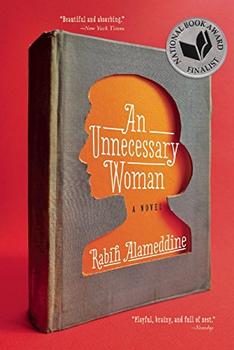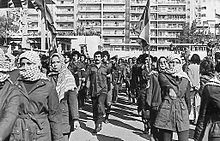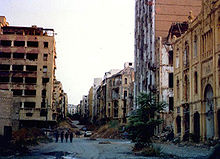Summary | Excerpt | Reviews | Beyond the Book | Read-Alikes | Genres & Themes | Author Bio

Critics' Opinion:
Readers' Opinion:
First Published:
Feb 2014, 320 pages
Paperback:
Nov 2014, 304 pages
 Book Reviewed by:
Book Reviewed by:
Naomi Benaron
Buy This Book
This article relates to An Unnecessary Woman
Lebanon is a tiny state (about two-thirds the size of Connecticut) bordering the Eastern shore of the Mediterranean Sea. Its geographical location, nestled between Syria to the north and Israel to the south, combined with the complex and delicate balance between its various ethnic and religious populations (totaling about 5 million), have endowed the country with a political role and influence far greater than its size would predict. Shaped by both European and Middle Eastern cultures, it has been, in the words of CNN's country profile, "the gateway between Christian Europe and the Arab Middle East and North Africa."
 The ethnic makeup of Lebanon is diverse and complicated by religious self-identification as well as centuries of influx and intermarriage. The four largest religious denominations are Sunni, Shia, Maronite (an ethnically distinct group of Christians), and Greek Orthodox. There is also a significant population of Druze, an ethnically Arab people whose monotheistic religion grew out of Shia Islam and is also influenced by Judaism, Christianity and Hinduism.
The ethnic makeup of Lebanon is diverse and complicated by religious self-identification as well as centuries of influx and intermarriage. The four largest religious denominations are Sunni, Shia, Maronite (an ethnically distinct group of Christians), and Greek Orthodox. There is also a significant population of Druze, an ethnically Arab people whose monotheistic religion grew out of Shia Islam and is also influenced by Judaism, Christianity and Hinduism.
Brief History
Between 1516 and 1918, the region that would become the country of Lebanon was part of the Ottoman Empire. In 1920, following the demise of the empire, the League of Nations granted France the mandate for Lebanon and Syria. In 1941, nationalist Lebanese leaders pressed for independence, and Lebanon was widely recognized as an independent nation. France, however, refused to cede their mandate. In March 1943, the two prominent Christian and Muslim leaders laid the groundwork for governance in a document that became known as al Mithaq al Watani (The National Pact). The system of governance was to be based on confessionalism, the proportional distribution of power according to religious populations. Relying on a 1932 census - no census has been taken since that time - the agreement specified that the president would be Maronite; the prime minister, Sunni; and the speaker of the Chamber of Deputies, Shia. The ratio of deputies favored Christians over Muslims six to five. In November 1943, France released its political prisoners and officially relinquished power. Independence day in Lebanon is celebrated on November 22nd.
The Civil War
The Lebanese Civil War lasted from 1975 to 1990. It left 150,000 dead; 17,000 missing; 300,000 injured; and 900,000, a fifth of the pre-war population, displaced (note: figures differ widely between sources). The key Lebanese factions were Palestinian and pro-Palestinian Muslim militias opposed to the status quo of the government, and the Phalanges Party who supported it. The Phalanges Party, also known as the Kataeb Party, was founded in 1936 by Lebanese Christians, four of them Maronite, as a nationalist movement dissatisfied with the economic and political status quo. The picture was also complicated by the emergence of Syria and Israel as key players fighting to maintain political advantage in the country.
 Civil war erupted on April 13, 1975 with the attempted assassination of Pierre Jumayyil, founder and leader of the Phalangist Party. The Phalangists retaliated by attacking a bus traveling through a Christian neighborhood, killing between twenty-six and thirty Palestinians. The Palestinians had been using Lebanon as a base for launching guerilla raids into Israel in 1967, although their main stronghold was in Jordan. The left-wing Lebanese National Movement (LNM) allied themselves with the Palestinians, while the Phalangists were allied with a coalition of Christian parties known as the Lebanese Front (LF). Large-scale killings followed in the mostly segregated ethno-religious communities of Beirut. Violence then spread to the entire nation. Although largely seen as a religious conflict, these religious divisions also reflected socioeconomic ones. The Maronite Christians were the elites. They held the majority political power and the greatest share of the country's wealth, whereas the politically and economically disadvantaged tended to be largely Shia Muslims.
Civil war erupted on April 13, 1975 with the attempted assassination of Pierre Jumayyil, founder and leader of the Phalangist Party. The Phalangists retaliated by attacking a bus traveling through a Christian neighborhood, killing between twenty-six and thirty Palestinians. The Palestinians had been using Lebanon as a base for launching guerilla raids into Israel in 1967, although their main stronghold was in Jordan. The left-wing Lebanese National Movement (LNM) allied themselves with the Palestinians, while the Phalangists were allied with a coalition of Christian parties known as the Lebanese Front (LF). Large-scale killings followed in the mostly segregated ethno-religious communities of Beirut. Violence then spread to the entire nation. Although largely seen as a religious conflict, these religious divisions also reflected socioeconomic ones. The Maronite Christians were the elites. They held the majority political power and the greatest share of the country's wealth, whereas the politically and economically disadvantaged tended to be largely Shia Muslims.
The Palestine Liberation Organization (PLO), and its militant Fatah wing, entered the fighting in early 1976. In June, with the Maronite-led government on the verge of defeat, Lebanon's president requested Syrian military aid, tipping the balance once more toward the regime. A conference in Riyadh, Saudi Arabia in October formally ended the first phase of the civil war. The agreement left the Arab Deterrent Force, consisting of 30,000 soldiers, 27,000 of which were Syrian, to enforce the peace. The city of Beirut was divided into Christian (East Beirut) and Muslim (West Beirut) sectors along the "green line."
 But the PLO continued to launch guerilla attacks into Israel and, in 1978, Israel invaded. On June 3 1982, members of Abu Nidal, a Fatah faction, attempted to assassinate Israel's ambassador to Britain. Israel responded on June 6th with a full-scale invasion under the direction of then Defense Minister Ariel Sharon. In September, the newly elected Phalangist president, Bashir Gemayel, was assassinated. In response, Phalangist militia entered the Palestinian refugee camps of Sabra and Shatila and slaughtered hundreds or perhaps thousands (the number is unknown) of Palestinian civilians. There was, at the very least, tacit approval from the Israelis. 1982 also saw the birth of the Shia Hezbollah organization.
But the PLO continued to launch guerilla attacks into Israel and, in 1978, Israel invaded. On June 3 1982, members of Abu Nidal, a Fatah faction, attempted to assassinate Israel's ambassador to Britain. Israel responded on June 6th with a full-scale invasion under the direction of then Defense Minister Ariel Sharon. In September, the newly elected Phalangist president, Bashir Gemayel, was assassinated. In response, Phalangist militia entered the Palestinian refugee camps of Sabra and Shatila and slaughtered hundreds or perhaps thousands (the number is unknown) of Palestinian civilians. There was, at the very least, tacit approval from the Israelis. 1982 also saw the birth of the Shia Hezbollah organization.
In August 1982, an agreement was signed calling for withdrawal of Israeli forces and the PLO, and the establishment of a multi-national peacekeeping force (MNF).
Factional fighting between the various militias, economic and political free fall, and the virtual collapse of the Lebanese army marked the period between 1983 and 1989. Several attempts to mediate a settlement failed. By 1988, there was a Muslim government in West Beirut and a Christian government in East Beirut, neither of which was recognized by the Central Bank. On the ground, governance fell to whichever militia was in charge of a given area.
In October 1989, meetings in Ta'if, Saudi Arabia produced the Charter of National Reconciliation. Not all parties accepted the treaty, notably General Michael Aoun, the prime minister appointed by the Phalangist president. Intense fighting followed. In 1990, Aoun was forced to flee, thus officially ending the civil war. Since then, most militias, with the exception of Hezbollah, have been disbanded. Syrian forces remained in Lebanon until 2005. The Israelis left in 1985, but attacked again in 1996 and 2006. Just as Lebanon's economy was rebounding, the Syrian conflict has sent waves of refugees into the country, straining its resources and once again igniting sectarian tensions as pro and anti Hezbollah forces skirmish.
1991GlobalSecurity.org map of the distribution of Lebanon's religious groups by Wikimedia Commons.
Fatah militia byTiamat, Crop, cleanup and re-up by Jaakobou.
Green line in Beirut by James Case from Philadelphia, Mississippi, U.S.A.
Filed under People, Eras & Events
![]() This "beyond the book article" relates to An Unnecessary Woman. It originally ran in February 2014 and has been updated for the
November 2014 paperback edition.
Go to magazine.
This "beyond the book article" relates to An Unnecessary Woman. It originally ran in February 2014 and has been updated for the
November 2014 paperback edition.
Go to magazine.





The House on Biscayne Bay
by Chanel Cleeton
As death stalks a gothic mansion in Miami, the lives of two women intertwine as the past and present collide.

The Flower Sisters
by Michelle Collins Anderson
From the new Fannie Flagg of the Ozarks, a richly-woven story of family, forgiveness, and reinvention.

The Funeral Cryer by Wenyan Lu
Debut novelist Wenyan Lu brings us this witty yet profound story about one woman's midlife reawakening in contemporary rural China.
Your guide toexceptional books
BookBrowse seeks out and recommends the best in contemporary fiction and nonfiction—books that not only engage and entertain but also deepen our understanding of ourselves and the world around us.